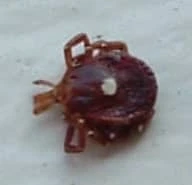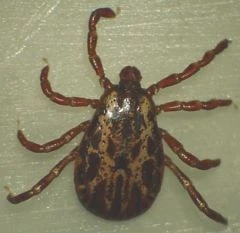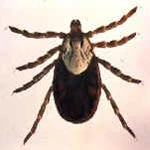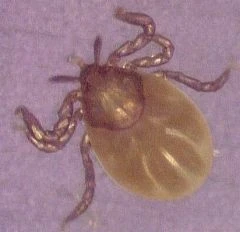What do Ticks Look Like?

So what do ticks look like…? Well this obviously depends on the species considering there are currently over 850 different types of ticks. In the picture on the left you can see a Deer Tick (one of the more common types to affect dogs and people).
Ticks are nasty little parasites that feed on the blood of a variety of different living creatures, mammals and people. Many people consider them to be insects but they are in fact arachnids. Each tick has four pairs of legs but will be born as an egg or seed with six legs before achieving adulthood where they are develop eight legs.
They are similar to spiders and have black legs which are attached to it’s abdomen. They are unable to fly and will crawl onto a host and then bite through the host’s skin, they will then suck it’s blood until its abdomen has expanded to allow it a maximum feed. They carry all kinds of diseases including Lyme disease, rocky mountain spotted fever, Tularemia and even Human monocytic ehrlichiosis. They are capable of feeding on a host for several days and their life cycle has four stages from seed or larva, to nymph, adult and then after mating the female lays her eggs.
 In this picture you can clearly see a Deer Tick. This is also known as the black legged tick and is one of the more common Ticks which has the ability to carry and pass on Lyme Disease to dogs but also to humans too.
In this picture you can clearly see a Deer Tick. This is also known as the black legged tick and is one of the more common Ticks which has the ability to carry and pass on Lyme Disease to dogs but also to humans too.
The Deer Tick or (Ixodes Scapularis) is capable of feeding on different hosts, including people during any point in their life cycle. They grow to about 1/8 inch as adults and are reddish brown in color. This variety are known to carry lyme disease and the risk of getting bites is much higher during the summer. This parasite can carry and transmit lyme disease, human anaplasmosis and babesiosis.
 In the picture to the left you can see the Lone Star (Amblyomma Americanum) tick. The female is very easy to distinguish from other species due to the very obvious white star that is at the center of it’s back. This type of tick tend to be very aggressive and have been known to crawl very long distances to attach themselves to a host. This variety are found ranging from Texas to as far north as Maine. It is worth mentioning that the Lone Star Tick does not cause Lyme disease in humans. People bitten by the Lone star may develop a red rash similar to the rash seen with Lyme disease this is actually a condition known as STARI or Southern Tick-Associated Rash Illness.
In the picture to the left you can see the Lone Star (Amblyomma Americanum) tick. The female is very easy to distinguish from other species due to the very obvious white star that is at the center of it’s back. This type of tick tend to be very aggressive and have been known to crawl very long distances to attach themselves to a host. This variety are found ranging from Texas to as far north as Maine. It is worth mentioning that the Lone Star Tick does not cause Lyme disease in humans. People bitten by the Lone star may develop a red rash similar to the rash seen with Lyme disease this is actually a condition known as STARI or Southern Tick-Associated Rash Illness.
If you do develop this rash you may also develop other symptoms such as muscle pains, tiredness, headaches and a raised temperature. If you want to learn more about this type of tick take a look at a The Centers for Disease Control and Prevention.
 In the picture to the left you can see the American Dog Tick or (Dermacentor Variabilis). This variety looks like the Rocky mountain spotted wood tick and the golf coast parasite although this version have shorter mouth parts. Males and females that have not fed are a reddy brown. Females have a largish silver spot just behind it’s head. In comparison the male has silver lines on it’s back.
In the picture to the left you can see the American Dog Tick or (Dermacentor Variabilis). This variety looks like the Rocky mountain spotted wood tick and the golf coast parasite although this version have shorter mouth parts. Males and females that have not fed are a reddy brown. Females have a largish silver spot just behind it’s head. In comparison the male has silver lines on it’s back.
This species also carry Rocky mountain spotted fever, Lyme disease, Tuleramia and Human Granulocytic Ehrlichiosis so it is one of the ticks that you should avoid at all costs.
 In the picture on the left you can see the Rocky Mountain Spotted Wood Tick or (Demacentor Andersoni). This species are quite robust and rounded but also carry a variety of diseases including rocky mountain spotted fever, Colorado fever and Tularemia. This type of tick are also one of the most common causes of tick paralysis.
In the picture on the left you can see the Rocky Mountain Spotted Wood Tick or (Demacentor Andersoni). This species are quite robust and rounded but also carry a variety of diseases including rocky mountain spotted fever, Colorado fever and Tularemia. This type of tick are also one of the most common causes of tick paralysis.
Rocky Mountain Spotted fever is caused by the bacteria rickettsia rickettsii and can be a potentially fatal condition. The most common symptoms of the illness includes fever, sickness and vomiting, headaches and abdominal pain.
 The picture on the left is of a Seed tick (the earliest stage in the tick life cycle). The Seed tick is very difficult to notice as it is no larger that a Pin head (less than a couple of millimetres in width).
The picture on the left is of a Seed tick (the earliest stage in the tick life cycle). The Seed tick is very difficult to notice as it is no larger that a Pin head (less than a couple of millimetres in width).
Due to the tiny size of Seed ticks if you have been outside in an area where you or your dog are likely to come into contact with them always check yourself for any sign of them on your clothes or on your dog’s coat. You can use tick repellents to reduce the chances of getting bitten but you can also use other techniques such as tucking your clothes in, wearing a hat and keeping a close eye on your pooch when out for a walk.





